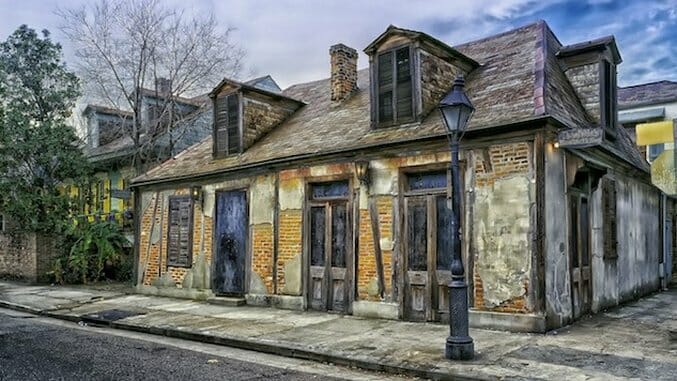Most visitors come to the Crescent City to enjoy what it’s famous for—jazz, delicious food and an all-around uplifting atmosphere. But as one of the oldest cities in the United States, New Orleans has a dark and eclectic history that many tourists don’t acknowledge. The city has undergone French, Spanish and British colonial periods, each leaving an indelible mark. From cemeteries with above ground burial vaults to old creaky mansions in the historic French Quarter, New Orleans’ haunted sites are almost as abundant as its jazz clubs—OK, not quite, but you get the picture. Below are five such places to check out when visiting New Orleans, especially during Halloween season.
1. LaLaurie Mansion
Located on the corner of Governor Nichols and Royal Street in the heart of the French Quarter, you’ll find the LaLaurie Mansion, once the residence of a well-to-do French Creole couple, doctor Louis LaLaurie and his wife Delphine. But behind the scenes, rumors abounded that the couple displayed unusual cruelty and torture to the family’s slaves. When a fire broke out at the mansion in the spring of 1834, these rumors were found to be true. Authorities found tortured and mutilated slaves—both dead and alive—in the home. After the discovery, the LaLauries were run out of the city by an angry mob. The mansion fell into ruin, but eventually was repurposed to become a school, then a music conservatory, and even a bar for a brief period of time. Over the years, occupants of the mansion have reported hearing moaning and phantom footsteps, and even seeing of the mansion’s tortured spirits.
2. Gardette-LaPrete House
Continue onto Dauphine Street, where you’ll find the Gardette-LaPrete House, another elegant mansion. Like many upper class residents of New Orleans, Jean Baptiste LaPrete, the mansion’s owner, fell onto hard financial times after the Civil War, and was forced to rent out his mansion. One of these renters was a wealthy young man from what is now Turkey, who threw lavish parties at his new residence. It was during one of these parties that the man and all of his guests were brutally attacked and murdered—a crime that remains unsolved to this day. The mansion, which soon became known as the Sultan’s Palace, was later converted into the New Orleans Academy of Art, a boarding house, apartments, and finally back to a private residence. But ever since that night, visitors to the mansion have reported seeing ghosts of the party guests and hearing the music that played during the party and distant screams.
3. Lafitte’s Blacksmith Shop
Head over to Lafitte’s Blacksmith Shop (pictured at top) for a drink and some tales. This building was constructed during the city’s French colonial period, making it the oldest continuously running bar in the United States. The bar is named for Jean Lafitte, one of New Orleans’ most colorful historical characters. It was here that Jean Lafitte allegedly ran his smuggling operation with his brother Pierre, who was a blacksmith. Lafitte wore many hats—privateer, spy, entrepreneur and even a hero of the Battle of New Orleans during which he provided supplies to General Jackson before a decisive battle with the British. Bar patrons have reported seeing apparitions of Lafitte himself, feeling a mysterious aura of coldness on the first floor and smelling the acrid cigar smoke indicating that Lafitte is near. There have also been sightings of an unknown woman and glowing red eyes peering at patrons through the grate of the bar’s fireplace. Needless to say, if you’re look for a lighthearted evening out, this might not be the place. But a séance? Perfect.
4. Hotel Monteleone
First-timers always make a stop at the well-known and gilded hotel on Royal Street, Hotel Monteleone, but many don’t know its storied past. Sicilian entrepreneur Antonio Monteleone purchased the building in 1886. It has remained in family hands ever since, successfully undergoing several expansions and even weathering the Great Depression. The hotel eventually became a literary landmark when famous authors such as Ernest Hemingway and William Faulkner began to frequent the hotel and other authors featured it in their work. But the hotel has a darker reputation as well. In the late 1890s, Maurice Begere, the young son of Jacques and Josephine Begere, died of yellow fever at the hotel. His ghost has been rumored to haunt the 14th floor, near the room where he died, ever since. There have also been sightings of the ghosts of former employees and guests such as William “Red” Wildemere, who died in the hotel of natural causes.
5. St. Louis Cemetery
No visit to New Orleans is complete without taking a tour of one of its famed cemeteries, and St. Louis Cemetery does not disappoint. The cemetery is actually made up of three Roman Catholic cemeteries that were constructed in the 18th and 19th centuries. The oldest and most well-known is Saint Louis No. 1, first opened in 1789 and featuring above ground vaults. Some famous names you’ll find buried here include Marie Laveau, famed voodoo queen of New Orleans; the aforementioned Delphine LaLaurie; and the first African-American mayor of New Orleans, Ernest N. “Dutch” Morial. Unsurprisingly, rumors of restless spirits at the St. Louis Cemetery abound. One such rumored haunting is that of Henry Vignes, a sailor who died of an illness when he returned from sea. Betrayed by his landlord, who sold his family tomb, he was buried in an unmarked grave at the cemetery instead of being interred with his family. Over the years, his ghost has been seen wandering throughout the cemetery, even appearing at funerals, still looking for an appropriate resting place.
Dylan Hill is a freelance writer currently based in Los Angeles.
